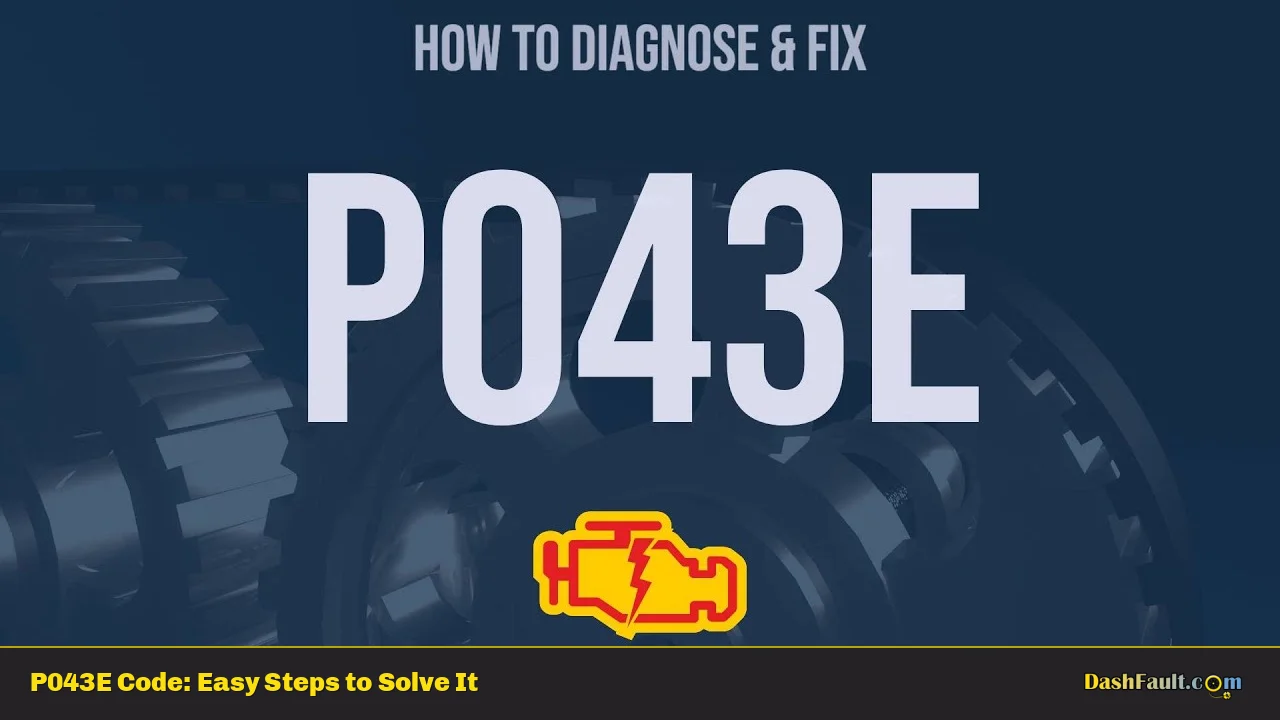The P043E trouble code is a diagnostic code that indicates an issue with the Evaporative Emission System (EVAP) in a vehicle. Specifically, it signifies a low flow condition detected in the leak detection reference orifice of the EVAP system. This orifice is crucial for measuring pressure and flow within the system, and when it becomes clogged or damaged, it can lead to increased emissions and potential failure during emissions testing. Understanding this code is essential for vehicle owners and DIY mechanics who may encounter it.
| P043E Code Meaning | P043E Code Common Causes |
|---|---|
| Evaporative Emission System Leak Detection Reference Orifice Low Flow | Clogged or damaged leak detection orifice |
| Indicates malfunction in the EVAP system | Defective EVAP pressure sensor |
| Potentially affects fuel vapor recovery | Faulty vent control or purge control solenoid |
| May trigger check engine light (CEL) | Cracked or crushed EVAP lines |
| Bad leak detection pump | |
| Charcoal canister failure |
Symptoms of P043E Code
When the P043E code is triggered, drivers may notice several symptoms, although some may be subtle:
- Check Engine Light: The most common indication is an illuminated check engine light (CEL).
- Reduced Fuel Efficiency: Drivers may experience slightly diminished fuel economy due to improper fuel vapor management.
- Emissions Test Failure: Vehicles may fail emissions tests if the EVAP system is not functioning correctly.
- No Significant Driveability Issues: Unlike other trouble codes, P043E typically does not cause noticeable driveability problems.
Technical Explanation of P043E Code
The P043E code is part of the OBD-II diagnostic system that monitors the performance of the EVAP system. This system captures and stores fuel vapors from the fuel tank to prevent them from escaping into the atmosphere. The leak detection reference orifice plays a critical role in this process by helping to create a pressure differential that allows the powertrain control module (PCM) to detect leaks.
When the PCM detects low flow through this orifice, it triggers the P043E code. This could be due to various factors, including blockages caused by debris, damage to components, or failures in associated sensors.
Step-by-Step Diagnosis of P043E Code
Diagnosing a P043E code involves several steps to accurately identify and resolve the underlying issue:
- Scan for Codes: Connect an OBD-II scanner to retrieve all stored codes. Note any additional codes that may provide context.
- Inspect Visual Components:
- Check for visible damage to hoses and connections in the EVAP system.
- Look for signs of wear or cracks in the charcoal canister.
- Test EVAP Components:
- Use a digital volt/ohmmeter (DVOM) to test the EVAP pressure sensor and other related components.
- Compare readings against manufacturer specifications.
- Check for Blockages:
- Inspect the leak detection reference orifice for clogs.
- Clean or replace any components as necessary.
- Clear Codes and Test Drive:
- Clear all codes from the PCM.
- Test drive the vehicle to see if the P043E code reappears.
Solution Methods for P043E Code
Resolving a P043E code typically involves one or more of the following methods:
- Replace Clogged Components: If debris is found in the leak detection reference orifice, clean it out or replace it altogether.
- Repair Damaged Hoses: Inspect and repair any cracked or damaged hoses that could be affecting airflow.
- Replace Faulty Sensors: If testing reveals that sensors are malfunctioning, replace them with new parts.
- Check and Replace Charcoal Canister: If the charcoal canister is ruptured or damaged, it must be replaced as part of restoring proper function to the EVAP system.
Cost Estimates for Repairs
The cost of addressing a P043E code can vary widely based on labor rates and parts prices:
- Diagnostic Fee: Typically ranges from $75 to $150 at a repair shop.
- Parts Replacement:
- Leak detection reference orifice: $50 – $150
- Charcoal canister: $150 – $300
- Sensors: $50 – $200 each
Total repair costs can range from approximately $150 to over $600 depending on what needs replacement.
Warnings and Recommendations
- Professional Help: If you are unsure about diagnosing or repairing your vehicle’s EVAP system, it is advisable to seek professional assistance.
- Avoiding DIY Risks: Attempting repairs without adequate knowledge can lead to further damage and increased repair costs.
- Regular Maintenance: Regularly inspect your vehicle’s emission systems as part of routine maintenance to prevent issues like those indicated by a P043E code.
Frequently Asked Questions About P043E
- What does P043E mean?
The P043E code indicates low flow through the evaporative emission system’s leak detection reference orifice. - Can I drive my car with a P043E code?
While you may not experience significant driveability issues, it’s best to address this code promptly to avoid potential emissions test failures. - What causes a P043E code?
This code can be triggered by clogged hoses, faulty sensors, damaged components, or issues within the charcoal canister. - How do I fix a P043E code?
Fixing this code involves inspecting and potentially replacing affected components within the EVAP system. - Is it safe to clear the error code?
You can clear the error code after repairs; however, if it returns, further diagnosis is necessary. - Will replacing parts guarantee fixing my car?
No, while replacing faulty components often resolves issues, it’s essential to ensure all related systems are functioning correctly. - How serious is a P043E code?
This trouble code primarily affects emissions control; however, neglecting it could lead to larger issues over time. - Do all vehicles have an EVAP system?
Most modern vehicles are equipped with an EVAP system; however, designs may vary between manufacturers.
In conclusion, understanding and addressing the P043E trouble code is vital for maintaining your vehicle’s performance and compliance with emission standards. By following proper diagnostic steps and solutions outlined above, vehicle owners and DIY mechanics can effectively manage this issue while ensuring their cars remain roadworthy and environmentally friendly.
